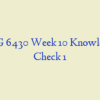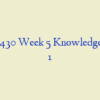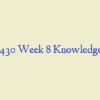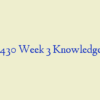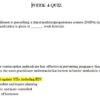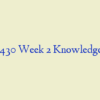Description
NSG 6430 Final Exam – Women’s Health Final
- The nurse practitioner knows that a highly valuable assessment tool for evaluating urinary incontinence and contributing factors in daily life is:
- The nurse practitioner is counseling a 57 year-old patient with urinary incontinence. The patient desires to try non-pharmacological, non-invasive methods of treatment at this time. Which of the following should be included in the patient’s plan of care? Select all that apply.
- The nurse practitioner is performing a bimanual exam on a new OB patient and notices that the lower portion of the patient’s uterus is soft. This is known as:
- Your female patient presents for vaginal discharge with an odor, and has noticed painless “bumps” on her vaginal area. Sexual history includes past male partners and her current female partner. On exam you note beefy red papules and an ulcerative lesion on her vulva, granular tissue and scarring, and inguinal adenopathy. You suspect she has:
- The physical examination of any woman suspected of being abused or battered includes all of the following except:
- The most effective means of obtaining the history of abuse is to use a communication model that:
- Clinicians should routinely consider intimate partner violence (IPV) as a possible diagnosis for women who present with all of the following except:
- The factors that enable women to enjoy and control their sexual and reproductive lives, including a physical and emotional state of well-being and the quality of sexual and other close relationships, make up a woman’s:
- Which one of the following is not among the ways clinicians can provide a welcoming, safe environment for Lesbian, Gay, Bisexual, or Transgender (LGBT) patients?
- Which one of the following is the definition of the term “gender identity”?
- Which one of the following statements about sexually transmitted infections (STIs) is false?
- Among the midlife health issues of women, the number one cause of mortality in the United States is:
- Lifestyle approaches to managing menopause-related vasomotor symptoms include:
- The standard for managing moderate to severe menopausal symptoms is:
- The nurse practitioner is managing an adolescent with a 4 cm functional ovarian cyst that was confirmed on a recent ultrasound. What plan of care should be anticipated for this patient?
- Non-pharmacologic therapy for chronic pelvic pain includes the following: Select all that apply.
- The nurse practitioner understands that all of the following organisms are responsible for infection of the Bartholin’s gland except:
- Treatment of a large, symptomatic Bartholin’s cyst includes all of the following except:
- A 44-year-old African American female presents with complaints of menorrhagia x 15 months. Pelvic ultrasound confirms the presence of large intramural leiomyomata. The nurse practitioner should discuss all of the following options with the patient except:
- The nurse practitioner is treating a patient with Elimite for scabies. The proper instructions to the patient should include:
- The nurse practitioner understands that the proper management of an asymptomatic woman with a small fibroid should include:
- The nurse practitioner is teaching a patient about pediculosis. Which of the following statements by the nurse practitioner is correct?
- All of the following medications may be used for neuropathic pain management of vulvodynia, except:
- The nurse practitioner understands that which of the following lab tests is appropriate for the patient who presents with symptoms of dysestheticvulvodynia?
- Which of the following is a common antibiotic for treatment of an infected Bartholin’s cyst?
- The patient presents with complaints of a painful, swollen lump in her vaginal area. She reports difficulty sitting and walking due to the pain. Which of the following is a likely diagnosis for this patient?
- The nurse practitioner understands that which of the following are differential diagnoses in an adult female patient with acute pelvic pain. Select all that apply:
- When women experience mild premenstrual symptoms, such as mild breast tenderness, abdominal bloating, and mild weight gain from water retention, this is known as:
- A patient with intraductal papilloma will commonly present with a chief complaint of:
- The nurse practitioner understands that the necessary screening techniques in a patient suspicious of ovarian cancer should include the following: Select all that apply.
- Early symptoms experienced by a woman with ovarian cancer include all of the following except:
- The nurse practitioner is evaluating a patient’s risk of ovarian cancer. All of the following factors are associated with an increased risk for ovarian cancer except:
- Patient education for condylomata acuminate should include all the following except:
- Tina is evaluated and diagnosed with Molluscum Contagiosum. The nurse practitioner understands that the clinical presentation of this disease is characterized by:
- Sara is 72 years old and has been a widow for 12 years. She presents for her yearly well-woman exam. Sara has not been sexually active since age 60. She has had regular pap screenings in her life and has had no abnormal pap tests. Sara asks if she needs a Pap test. Your response would be:
- Misty presents with a painful “sores” in her perineal area, dysuria, and dyspareunia. On exam, she has 2 shallow ulcerated lesions on the right labia majora and one on the left. She also presents with enlarged inguinal lymph nodes. Based on these findings you suspect she has:
- Which of the following is not true for HIV infection evaluation?
- The nurse practitioner understands that the risk factors for developing vaginal candidiasis include which of the following
- Cindy presents to your clinic for STI testing after realizing her current boyfriend has been seeing other women. She states she was told that one of the women has hepatitis B. Your patient education regarding hepatitis B includes all the following except:
- Stacy has made an appointment at your clinic for c/o dysuria. During the HPI she explains, “My bottom hurts when I pee, and I have bumps there”. She has never had this before and is worried. She denies fever, although she feels “a little like I have the flu” explaining she has a headache and feels achy and tired. She denies exposure to a STI noting she and her partner have been monogamous for 6 years. On exam you notice a cluster of painful vesicles adjacent to the vaginal introitus. The most likely diagnosis is:
- You see an 18-year-old woman with a history of Chlamydia infection and a total of five-lifetime partners. Based on the latest evidence-based guidelines, you recommend:
- Karen was recently diagnosed with primary syphilis. The nurse practitioner understands that the first-line treatment option for primary syphilis include:
- While educating Karen about the different stages of syphilis, which of the following is not representative of the presentation of secondary syphilis?
- Karen was recently diagnosed with primary syphilis by her primary care provider, she is very upset and inquires how long after sexual contact do syphilis symptoms typically occur. What is the correct response by the primary care provider?
- Which of the following terms describe the mechanism of action of Imiquimod (Aldara) in the management of genital warts?
- The nurse practitioner understands that HPV types _____ and ____are most often associated with cervical and anogenital cancer.
- Jenna was evaluated and diagnosed with condylomaacuminatum. Treatment options for Jenna will include all of the following except:
- Which of the following is a treatment option for a 30-year-old woman with PID and a history of severe hive-form reaction when taking penicillin or cephalosporin?
- The nurse practitioner understands that a complication of gonococcal and chlamydial genitourinary infection in women include which of the following:
- The nurse practitioner understands that women with PID typically present with all of the following except:
- Elizabeth was evaluated and diagnosed with a primary outbreak of genital herpes in the clinic today. The treatment plan for Elizabeth will include a prescription for:
- Elizabeth was recently diagnosed with genital herpes after having unprotected intercourse with a new partner. The nurse practitioner explains to Christine that the incubation period for HSV Type 2 is approximate:
- Kristin returns to the clinic for follow-up on STI results. The nurse practitioner informs her the Chlamydia test was positive. Which of the following agents will the nurse practitioner prescribe for treatment?
- The nurse practitioner student is studying the CDC guidelines for treating sexually transmitted infections. Which of the following agents is recommended for Gonorrhea treatment?
- A 30-year-old woman presents without symptoms but states that her male partner has dysuria without penile discharge. The examination of the woman reveals a friable cervix with yellow discharge from the cervical os. This description is most consistent with an infection caused by: Select all that apply.
- Karen was diagnosed with trichomoniasis by her primary care provider and treated with:
- A 24-year-old woman presents with a 1-week history of thin, greenish-yellow vaginal discharge with perivaginal irritation. Physical examination findings include vaginal erythema with petechial hemorrhages on the cervix, numerous white blood cells, and motile organisms on microscopic examination. These findings most likely represent:
- For patients needing topical treatment for vulvovaginitis caused by Candida albicans, the nurse practitioner will prescribe:
- The nurse practitioner understands that women with bacterial vaginosis typically present with:
- The U.S. Preventative Services Task Force (USPSTF) recommends ____________ of the folic acid supplement daily at least one month before conception for all women with an average risk for neural tube defects.
- The American College of Obstetrician &Gynecologists recommend that all pregnant women be offered aneuploidy screening before 20 weeks gestation. This test identifies women whose fetuses are at increased risk for which of the following? Select all that apply.
- An important part of patient education for the patient with bacterial vaginosis who is receiving a prescription for oral Metronidazole is:
- For the patient with chronic bacterial vaginosis, the nurse practitioner will prescribe:
- The nurse practitioner’s exam findings on a patient with vaginal Candidiasis is positive for all of the following except:
- A woman arrives at the clinic for a pregnancy test. Her last menstrual period (LMP) was February 14, 2017. Using Nageles Rule, what is the client’s expected date of birth (EDB)?
- Which documentation on a woman’s chart on postpartum day 14 indicates a normal involution process?
- The nurse practitioner understands that the hormone, __________, remains elevated in breastfeeding women in the postpartum period.
- The nurse practitioner is recommending daily Calcium supplementation of ___________ to her female patients that are older than 50 years of age.
- Osteoporosis is diagnosed when the patient’s bone density is more than ______ standard deviation(s) below the average bone mass for women younger than 35 years old.
- Based on the latest ACOG guidelines, the nurse practitioner understands that the recommended time to initiate screening for cervical cancer in women is:
- The nurse practitioner understands the following lifestyle approaches may be used to prevent osteoporosis after menopause: Select all that apply.
- What is the primary role of a nurse practitioner in the research process?
- Whether you order diagnostic testing or refer the patient to an HIV-specific facility, laboratory confirmation is rendered. The test confirming HIV infection is _____________.
- The nurse practitioner is examining a twenty-nine-year-old female with a three-day history of dysuria and urinary frequency. On examination, the patient is positive for suprapubic tenderness and negative for costovertebral angle (CVA) tenderness. This most likely represents which of the following?
- A patient has been diagnosed with trichomoniasis. Which of the following single-dose medications would be the best option?
- When educating patients about the use of combination oral contraceptive medications, they should be advised that pregnancy is prevented primarily by ____________.
- A twenty-four-year-old female presents to the office with a complaint of a “yucky” vaginal discharge. On exam, a milky vaginal discharge is noted. A wet mount preparation reveals a positive whiff test and 75% clue cells. There were no trichomonads or WBCs visualized. Which of the following would be the most likely diagnosis in this patient?
- A fifty-five-year-old postmenopausal female patient presents with pain in the upper outer quadrant of her left breast for over one month now. The best course of action would be to _______.
- A thirty-nine-year-old female has just completed a course of Amoxicillin for the treatment of streptococcal pharyngitis. Her LMP was two weeks ago and reports that it was normal for her. On physical examination, there is some erythema of the external genitalia with a small amount of white discharge. The microscopic wet prep examination reveals few clue cells but an abundance of budding hyphae. There are no WBCs present. Considering the differential diagnoses and results of the microscopic examination, which of the following would be the most appropriate treatment?
- A forty-nine-year-old female patient presents with a chief complaint of dark, watery brown vaginal discharge. Part of the differential diagnosis includes that of cervical cancer. Which of the following best describes what might be visualized on physical examination in patients with cervical cancer?
- A twenty-five-year-old female presents with vaginal irritation and discharge. On examination, the cervix is easily friable and erythematous. There is no adnexal tenderness. The wet prep (wet mount) microscopic examination reveals mobile protozoa on the normal saline slide. This most likely represents _________.
- A twenty-two-year-old female presents with an initial onset of herpes simplex on the external genitalia. During the patient education, which of the following statements is most important to include?
- Follicle-stimulating hormone (FSH) is released from the anterior pituitary gland and is responsible for which of the following normal physiologic response of the female menstrual cycle?
- A thirty-two-year-old patient comes in for a workup of infertility. During the history, the nurse practitioner suspects that the patient may be experiencing anovulatory cycles. In order to confirm ovulation, which of the following tests would be most appropriate to order?
- A nurse practitioner is performing a wet mount with potassium hydroxide (KOH) to assist with a diagnosis in a woman experiencing vaginal discharge. Which of the following would this confirm?
- A nurse practitioner is completing a speculum exam on a female patient. Which of the following findings would be considered a normal surface characteristic of the cervix?
- There are several phases to the menstrual cycle. What phase begins with menses cessation and ends with ovulation?
- A nurse practitioner is participating in a women’s health fair. When educating the women about risk factors for breast cancer, which of the following statements is incorrect?
- The first-line treatment of severe menstrual cramps that have been occurring for four months in a patient with primary dysmenorrhea includes which of the following?
- Which of the following choices represents a disorder of the reproductive tract that causes pain, erythema, dyspareunia, and a perineal mass?
- A woman is concerned that she may develop breast cancer and is discussing her concerns with the nurse practitioner. Which of the following is not an associated risk factor for this?
- A sixty-one-year-old thin, Caucasian female presents to your practice for a well-woman examination. She remarks that she feels like she is shrinking over the past year, despite keeping active and incorporating sources of calcium in her diet. Which of the following is not a risk factor for osteoporosis?
- A thirty-five-year-old woman presents with a six-month history of hypermenorrhea, backache, and pelvic pressure. On examination, you discover a twelve-week size uterus with an irregular contour. Which of the following does this most likely represent?
- It is known that a woman who is menopausal has an increased risk of heart disease. Which of the following lipid changes occur with estrogen withdrawal in menopause?
- Which of the following is true regarding the education of a forty-two-year-old woman diagnosed with a uterine myoma?
- Sheryl, a seventeen-year-old, complains of vaginal discharge for the past month. When she wipes after urinating, there is “white stuff” on the tissue. Sheryl denies urinary problems but has had some genital itching, but no odor. She also denies sexual activity. Her vaginal discharge is most likely a result of ______.
- Urinary tract infections are commonly seen in primary care. A twenty-five-year-old female presents with a new onset of dysuria and suprapubic pain for the last twenty-four hours. The examination reveals only mild tenderness without any peritoneal signs on the lower abdomen. A urinalysis reveals the presence of WBCs. The urine is sent for a culture and sensitivity. In addition to Escherichia coli one might typically expect to see the presence of which bacterium?
- The pituitary gland is responsible for a variety of functions with respect to hormonal regulation and is composed of two lobes, the anterior and posterior sections. Which of the following list of hormones are secreted by the anterior pituitary gland?
- The nurse practitioner is counseling a patient on the side effects associated with some birth control methods. The woman complains that she has developed acne and hirsutism while taking oral contraceptives. The nurse practitioner understands that these changes result from _____.
- You are meeting with twenty-two-year-old Emily to discuss birth control options. She has tried “the pill” in the past but failed to take it regularly. She is interested in depo because she only has to come in every three months for a shot. She also heard that one does not get a period on depo, and she likes the thought of that. Which of the following would be a specific consideration with depo that you would need to discuss with Emily based on her desires for a birth control method?



